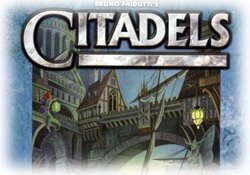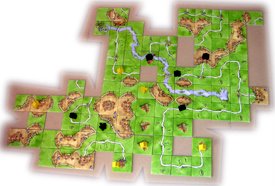
The next game played on Monday, December 5, 2005 is one that I (Chris) have been itching to play since I heard about this club.
We played Citadels with SIX players: Chris, Manny, Cathy, Jake, Matt, and Charles.You are trying to build a city. There are cards in the game which picture different buildings (they are called districts), and cards which portray characters.
Each turn of the game is played in 2 parts. Each person first picks a role to play -- Assassin, Thief, Magician, King, Bishop, Merchant, Architect, or Warlord, from the character cards. The King chooses first, and then the cards are passed around the table for each of the other players to choose.
Each of these characters has an ability, that sort of makes sense -- the Assassin can kill another character(they lose a turn), the Thief can steal all the money from another character, the Architect can build his empire faster than others, and the Warlord can destroy buildings. Other characters can provide you income from your buildings.
The second phase is where you can get money or more building cards, and build a building -- as well as use the special ability of the character card.
As the game progresses, different people will tend to gravitate towards using certain cards -- you don't want to do this because you will become a target of the Assassin and Thief. The neat thing is -- you choose your character in secret. The Assassin and thief target a CHARACTER not a PLAYER. So, for example, the person representing the Assassin announces that he or she is targeting the Merchant or Warlord. You don't know which player that is -- it's a sort of guess. You may have just killed a player unintentionally.
Once a person succeeds in building 8 districts, the game is scored, with a bonus for being the first to that, and bonuses for a variety of different kinds of districts.
Here's how the game went -- at least the killing and stealing parts!
- In the first turn Manny killed the Architect (which turned out to be Charles).
- Matt stole all the money from the King (it was Cathy).
- Matt killed the Thief (Jake).
- Matt then killed the Warlord (Chris).
- Matt attempted to kill the King, which turned out to not be chosen.
- Charles stole from the Merchant (Cathy).
- Manny ended a turn as the King, which means he calls out the orders for the characters to do their turn next. He called for the Bishop to come forward repeatedly, and no one claimed the turn. We got done with the round and realized Manny hadn't played -- he was the Bishop! It was funny if you were there...
- On the very next turn, Charles assassinated the Warlord. When you are assassinated, you are supposed to just be quiet and sit out the turn. Manny moaned loudly, and showed everyone else that he was the Warlord. Again, it was funny at the time.
- After laughing at Manny's mistakes, Chris, who had picked last so he knew what cards went unused, picked the Thief, and announced that he was stealing from the Merchant -- a card he had, just a few moments ago, laid unclaimed on the table.
- Manny used his Warlord power and 5 gold to destroy Charles' School of Magic.
At this point, 1:00 was swiftly approaching, and both Cathy and Jake had class to attend -- they left, and the rest of us finished up.
- Matt tried to steal from the Warlord (who went unclaimed).
- Chris used his Warlord power to destroy Charles' Watchtower -- being a one-gold valued property, it was destroyed for free. Chris laughed maniacally.
- Matt killed the Merchant (he assumed it was Charles, it was Chris).
- Charles rebuilt his Watchtower, one turn after it was destroyed. He also laughed maniacally.
- At this point, both Chris and Charles have 7 districts -- one away from completion.
- Matt killed the Bishop (he assumed it was Charles, it was Chris -- sound familiar!?!?).
- Manny decided to kill the Magician (which turned out to be, of course, Chris again).
- Charles built his last of 8 districts as a Warlord -- destroying one of Chris' properties to make a wider margin of victory, and, in my humble opinion, also for spite.
Here's the final value of the cities of the folks who finished:
| Citadels final scores |
| Charles | Matt | Chris | Manny |
| 26 | 26 | 17 | 16 |
| +4 for 8 districts first |
| 30 point winning total |
It's just as interesting to see who committed which felonies, and who fell victim... here's the leaderboard for that:
| Assassinations |
| Assassins |
| Matt | 5 (1 was unsuccessful) |
| Manny | 2 (note: it was his very first and very last action in the game) |
| Charles | 1 |
| Victims |
| Chris | 4 (ouch!) |
| Charles | 1 |
| Jake | 1 |
| Manny | 1 |
| Robberies |
| Thieves |
| Matt | 2 (1 was unsuccessful> |
| Charles | 1 |
| Chris | 1 (and it was NOT successful |
| Victims |
| Cathy | 2 |
| Districts Destroyed |
| Warlords |
| Charles | 1 |
| Chris | 1 |
| Manny | 1 |
| Victims |
| Charles | 2 |
| Chris | 1 |
So, in the dark side of Citadels, we can see some trends -- Matt liked killing, and Chris liked dying. Most of the time it was announced that Chris was really not the intended target, he just happened to be in the wrong place making the assassinations more like drive-by shootings.
Also, the thieves were spread around, but Cathy must have been walking down a dark alley with $20 bills hanging out of her pockets, being the only victim of the crime.








